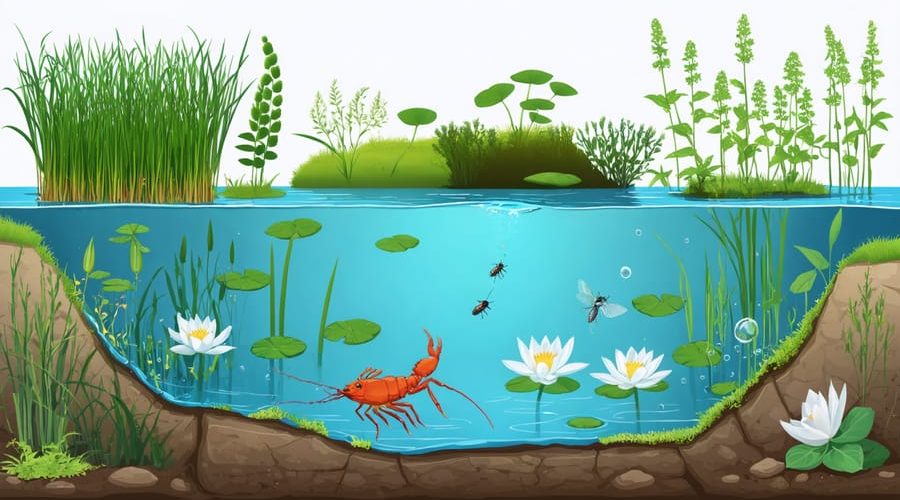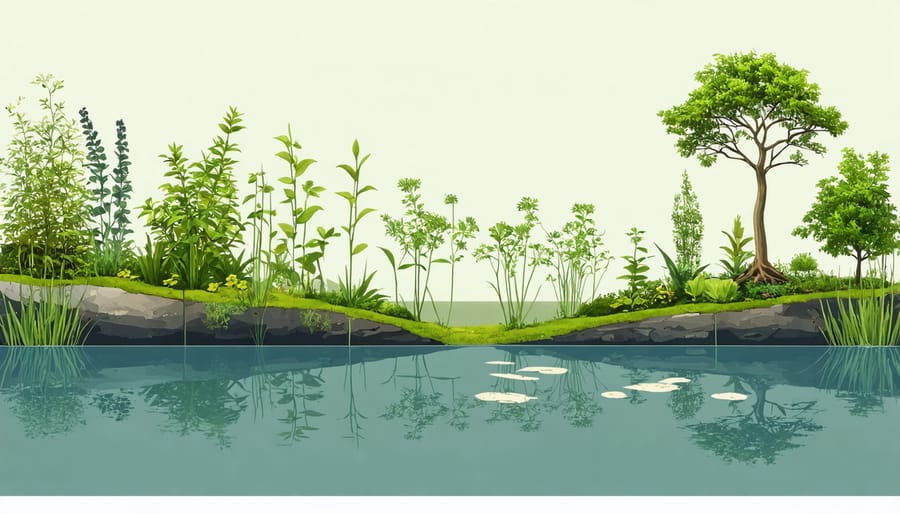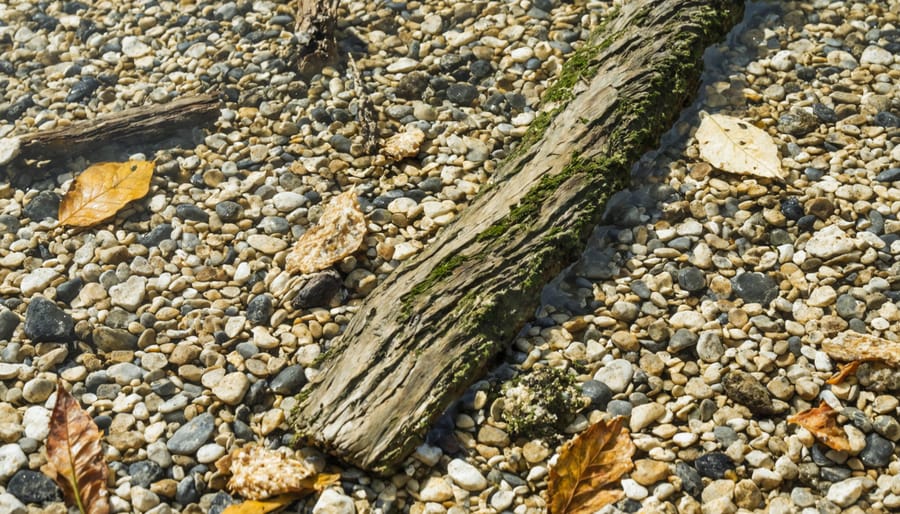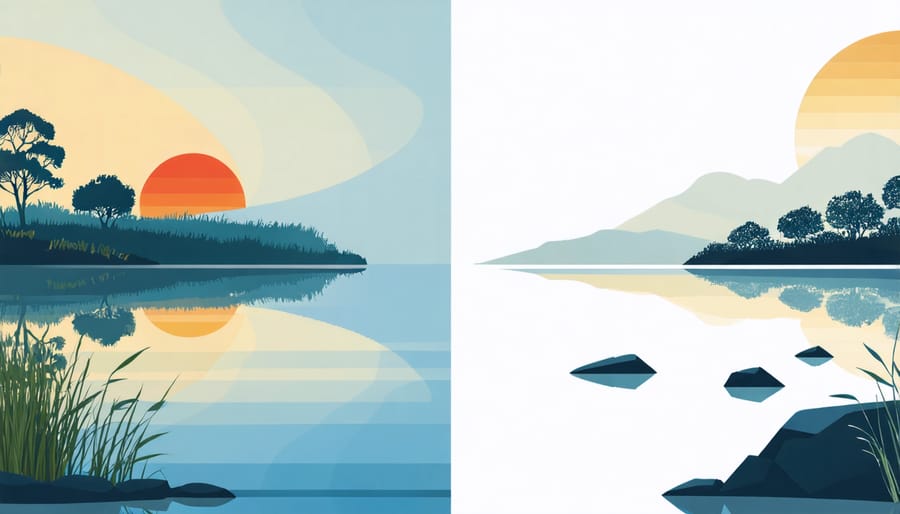
Create a Thriving Underwater World: Simple Ways to Support Pond Invertebrates
Create thriving diverse aquatic microhabitats by layering different substrate materials – starting with coarse gravel at the bottom, followed by smaller pebbles, and topped with aquatic soil. This natural gradient supports various invertebrate species, from bottom-dwelling crayfish to surface-skimming water beetles.
Position partially submerged logs and native water plants strategically around your pond’s edges, establishing essential shelter zones where aquatic insects can lay eggs and hide from predators. These edge habitats become vital nurseries for developing invertebrate populations.
Maintain water quality through a balanced mix of submerged oxygenating plants and floating vegetation, covering roughly 60% of the water surface. This plant diversity creates multiple feeding and breeding zones while naturally filtering the water, perfect for sustaining healthy populations of water snails, dragonfly nymphs, and other beneficial invertebrates.
Design different depth zones within your pond, ranging from shallow 6-inch shelves to deeper 3-foot sections. These varying depths create temperature gradients and oxygen-rich environments that attract and support a wider variety of invertebrate species throughout the seasons.
Essential Habitat Features for Pond Invertebrates
Aquatic Plant Zones
Healthy underwater plant zones are essential for creating a thriving invertebrate habitat in your pond. These zones typically include emergent plants at the margins, floating plants on the surface, and submerged plants in deeper areas. Each zone serves a unique purpose in supporting invertebrate life.
Marginal plants like rushes and irises provide vital shelter for dragonfly larvae and water beetles, while their stems serve as emergence points for developing insects. Floating plants such as water lilies offer shade and protection from predators, creating perfect hiding spots for water snails and small crustaceans.
Submerged plants are particularly important as they offer both shelter and food sources. Plants like hornwort and water milfoil provide excellent surfaces for invertebrates to lay their eggs and for tiny creatures to graze on beneficial algae. These underwater forests also help maintain water quality by absorbing excess nutrients and producing oxygen, creating an ideal environment for your pond’s smallest inhabitants.
For best results, aim to include plants from each zone, creating a diverse ecosystem that supports a wide variety of invertebrate life.

Bottom Substrates
The foundation of any thriving invertebrate habitat starts with choosing the right bottom substrate. A mix of different materials creates diverse microhabitats that cater to various species. Sand provides an excellent base layer, allowing burrowing creatures like freshwater clams and some types of worms to dig and filter feed comfortably. Small gravel (about 1/4 to 1/2 inch in diameter) offers hiding spots for tiny crustaceans and aquatic insects.
Adding larger rocks and cobbles creates additional spaces where crayfish and snails can find shelter. These varying sizes of stones also collect beneficial biofilm, which many invertebrates feed on. Consider incorporating some clay-based substrates too – they’re perfect for species that need to construct tubes or burrows.
Dead leaves and small twigs make great natural additions, mimicking the organic matter found in natural ponds. They break down slowly, providing food and shelter for detritivores like water sowbugs and amphipods. Just be sure not to add too much organic material at once, as excessive decomposition can affect water quality.
For best results, layer these materials to create zones of different depths and textures throughout your pond or aquarium.
Creating Perfect Hiding Spots

Natural Materials
Creating natural hiding spots using materials found in nature is one of the best ways to encourage invertebrates to make your pond their home. Rocks of varying sizes form the foundation of these hideaways, with larger stones creating caves and crevices where creatures can retreat from predators. Stack rocks carefully to create stable structures, ensuring there are plenty of gaps and spaces between them.
Fallen branches and logs add another dimension to your invertebrate habitat. Look for hardwoods that decompose slowly, as these will provide long-lasting shelter while gradually releasing nutrients into the water. Position wood pieces so they’re partially submerged, creating zones that transition from water to air – perfect for amphibious invertebrates.
Leaf litter is equally important, serving as both shelter and food source. Oak, beech, and maple leaves work particularly well as they break down slowly and support beneficial bacteria. Add them in moderate amounts during autumn, allowing them to settle naturally around the pond edges and between rocks.
Remember to layer these materials thoughtfully. Start with larger rocks at the bottom, add medium-sized stones and wood pieces in the middle, and top with smaller stones and leaf litter. This creates a complex environment that mimics natural pond beds, providing countless nooks and crannies for invertebrates to explore and colonize.
Artificial Structures
Creating artificial structures in your pond provides essential shelter and breeding spaces for invertebrates while adding visual interest to your water feature. One of the simplest solutions is to add stack stones or bricks with plenty of nooks and crannies. Arrange these along the pond’s edge or in shallow areas to create mini caves and hiding spots.
Ceramic pots laid on their sides make excellent invertebrate homes – just be sure to use untreated, natural materials. Break them in half or create small entrance holes to make them more accessible. Bamboo bundles, secured together and partially submerged, provide perfect tubular shelters for many small creatures.
For a more natural look, try creating brush piles using fallen branches and twigs. These can be weighted down in shallow areas, offering both shelter and surfaces for algae growth – a favorite food source for many invertebrates. Old logs, when properly prepared and anchored, make excellent habitats as they slowly decompose.
Commercial options include purpose-built invertebrate shelters and “bug hotels” designed specifically for aquatic environments. These often feature multiple chambers and various-sized openings to accommodate different species. However, DIY alternatives can be just as effective and more budget-friendly.
Remember to position these structures at different depths to create a diverse habitat range, and avoid using materials that might leach chemicals into the water.
Water Quality for Invertebrate Success
Oxygen Levels
Maintaining proper oxygen levels is crucial for the survival of pond invertebrates. Most aquatic invertebrates need well-oxygenated water to thrive, and there are several effective ways to ensure this. Adding a waterfall or fountain creates movement that naturally incorporates oxygen into the water while adding visual appeal to your pond.
Plants play a dual role in oxygen management – underwater plants release oxygen directly into the water during daylight hours, while floating plants provide shade that prevents excessive algae growth, which can deplete oxygen levels. Consider adding water lilies, hornwort, or anacharis to help maintain healthy oxygen levels.
For smaller ponds, a simple air pump with an air stone can provide consistent oxygenation. Place the air stone in a deeper area of the pond where invertebrates tend to gather. During hot summer months, when oxygen levels naturally decrease, you might need to add an extra air stone or increase water movement.
Monitor your pond in the early morning hours, as oxygen levels are typically lowest at dawn. If you notice invertebrates gathering near the surface gasping for air, it’s a clear sign that oxygen levels need attention. Regular maintenance, including removing excess organic matter and preventing overcrowding, will help maintain optimal oxygen conditions for your invertebrate community.
Water Parameters
Maintaining proper water parameters is crucial for a thriving invertebrate habitat. Regular monitoring helps ensure your aquatic friends stay healthy and happy. The most important parameters to check are pH, ammonia, nitrites, and dissolved oxygen levels.
For most pond invertebrates, aim to keep the pH between 6.5 and 8.0. Test weekly using a reliable water testing kit, especially during seasonal changes. Ammonia and nitrites should always read zero, as these compounds can be toxic even in small amounts. If you detect any, perform a partial water change immediately.
Dissolved oxygen is vital for invertebrate survival. Keep your water well-oxygenated by including moving water features like fountains or waterfalls. A good target is 6-8 mg/L of dissolved oxygen. You can measure this with a digital meter or observe your invertebrates – if they’re clustering near the surface, they might need more oxygen.
Temperature also plays a key role. Most pond invertebrates thrive between 65-75°F (18-24°C). Sudden temperature swings can stress them, so use floating thermometers to monitor changes. Adding shade plants helps maintain stable temperatures and provides additional shelter for your tiny pond residents.
Remember to test your water parameters at the same time each day for the most accurate readings.

Seasonal Care Tips
Winter Protection
As winter approaches, protecting your pond’s invertebrate population becomes crucial for maintaining a healthy ecosystem year-round. Many invertebrates have natural survival strategies, but you can help them thrive during the cold months with some simple preparations.
First, avoid removing all fallen leaves from your pond. While excess debris should be cleared, leaving some leaves at the bottom creates natural shelter where invertebrates can hibernate. A thin layer of organic matter provides both protection and food sources throughout winter.
Adding a few submerged logs or branches gives invertebrates additional places to hide when temperatures drop. Position these near the bottom of your pond where the water remains slightly warmer. For smaller ponds, consider installing a pond net to prevent too many leaves from falling in while still allowing some beneficial debris to accumulate.
If your pond freezes over, maintain a small opening in the ice for gas exchange. However, avoid breaking the ice directly, as this can shock hibernating creatures. Instead, use a floating de-icer or similar device to keep a small area free from ice.
For shallow ponds, consider adding extra depth to certain areas before winter. A deeper section of at least 2 feet provides a stable environment where temperatures remain more consistent, giving invertebrates a better chance of survival during freezing conditions.
Remember that some population loss during winter is natural, but these protective measures will help ensure enough invertebrates survive to maintain your pond’s ecological balance come spring.
Summer Management
Summer brings unique challenges for maintaining healthy invertebrate habitats, but with the right approach, you can keep your aquatic friends thriving through the warm months. The key is managing water temperature and oxygen levels, which directly impact invertebrate health and activity.
Start by ensuring adequate shade coverage over your pond or water feature. Adding floating plants like water lilies not only creates natural shelter but also helps regulate water temperature. If you don’t have natural shade, consider installing a shade sail or strategically placing potted plants around the edges.
Monitor water levels closely during summer, as evaporation increases. Top up when needed, but do so gradually to avoid shocking your invertebrates with sudden temperature changes. Using collected rainwater is ideal, as it’s free from chemicals and closer to natural conditions.
Maintain good water circulation to boost oxygen levels. Your pumps and filters should run consistently, especially during hot spells when oxygen levels naturally decrease. Consider adding a small fountain or waterfall feature if you don’t already have one – the moving water creates valuable oxygen-rich zones.
Keep an eye on algae growth, which tends to surge during warm weather. While some algae provide food for invertebrates, excessive growth can deplete oxygen levels overnight. Remove string algae manually and ensure your filtration system is working efficiently.
During heat waves, avoid major cleaning or maintenance tasks that might stress your invertebrate population. Instead, focus on gentle, regular maintenance like removing debris and ensuring water movement continues uninterrupted.
Creating a thriving invertebrate habitat in your pond isn’t just about aesthetics – it’s about fostering a vibrant, self-sustaining ecosystem that benefits all aquatic life. By following the guidelines we’ve discussed, you can transform your water feature into a haven for these fascinating creatures. Remember to focus on providing diverse vegetation, maintaining proper water quality, and creating varied depths and hiding spots.
Start small and build gradually, observing how different additions affect your pond’s ecosystem. Don’t be afraid to experiment with different plants or substrate materials to find what works best in your specific environment. The key is to maintain consistency in your maintenance routine while allowing nature to find its balance.
Take action today by implementing just one or two suggestions from this guide. Whether it’s adding some native plants or creating a shallow gravel area, every small step helps. Share your success stories with other pond enthusiasts and continue learning from their experiences. Your efforts in creating and maintaining an invertebrate habitat will reward you with a healthier, more dynamic pond ecosystem that brings joy year after year.
